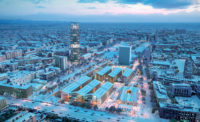Vancouver's Olympic Village Aims High on Sustainability Scale
Correction appended August 27, 2009
Beijing and London made headlines last year for building sustainable facilities for the Olympic Games. Now, Vancouver is continuing that trend by going for LEED Gold.
All 16 residential buildings in the city’s 2010 Winter Olympics Athlete’s Village will meet the USGBC’s Gold-level sustainability standards, according to Ian Smith, manager of the development office for Southeast False Creek, the district where the complex is located. Additionally, a 30,000-square-foot community center will be certified LEED Platinum.

The 1.4-million-square-foot complex will accommodate 3,000 athletes competing in the 2010 Winter Games.
The 1.4-million-square-foot complex will accommodate 3,000 athletes competing in the Winter Games, which start February 12, 2010. Master-planned by HBBH Architects’ Norm Hotson, along with VIA Architecture and PWL Partnership, the village is being constructed on Vancouver’s last strip of undeveloped waterfront, on an abandoned industrial site. Designers of individual buildings—mostly mid-rise structures made of glass and steel—include Arthur Erickson, Merrick Architecture, GBL Architect Group, Lawrence Doyle Young Wright Architects, Walter Francl Architect, and Nick Milkovich Architects, all based in Vancouver.
The project exemplifies sustainable design. The 100-acre site (approximately eight city blocks) faces west, maximizing daylighting and natural ventilation strategies, says Scot Hein, senior planner for the city of Vancouver. Green features include rainwater harvesting, a sewer-heat recovery system, and intensive green roofs; interiors will contain low-VOC materials made of recycled or sustainable resources. One of the buildings is designed to generate as much energy as it uses. “The Olympic Village development represents a strong civic statement with regards to housing mix, the quality of the public realm, and leadership in sustainable development,” says architect Nick Milkovich, whose firm designed the two most prominent waterfront residential buildings.
Perhaps the most sustainable attribute is the long-term plan for the site: Once the Games are over, the Athlete’s Village will be converted into a mixed-use development. “Hardly any retrofitting will be needed after the Games,” says Smith. Ground-level units that will serve as training, dining, and healthcare facilities for athletes will be transformed into restaurants and shops, while living quarters will become private residences. The complex will feature low-income housing and market-rate units. In total, 737 residences will be offered for sale; in the two Milkovich-designed waterfront towers, these condos may fetch upward of $4.3 million each.
Many Olympic host cities, such as Athens and Barcelona, are now populated with empty facilities built for the Games. But when it comes to the Athlete’s Village, Vancouver isn’t worried about the so-called “Olympic Curse.” According to Smith, of the 300 units already put up for sale, 90 percent are sold. The rest will hit the market after the Games.
Correction: Due to information provided to the writer, Norm Hotson of HBBH Architects was identified as the sole master planner of Olympic Village. In fact, there were other Vancouver-based firms involved, including VIA Architecture and the landscape architecture firm PWL Partnership.


